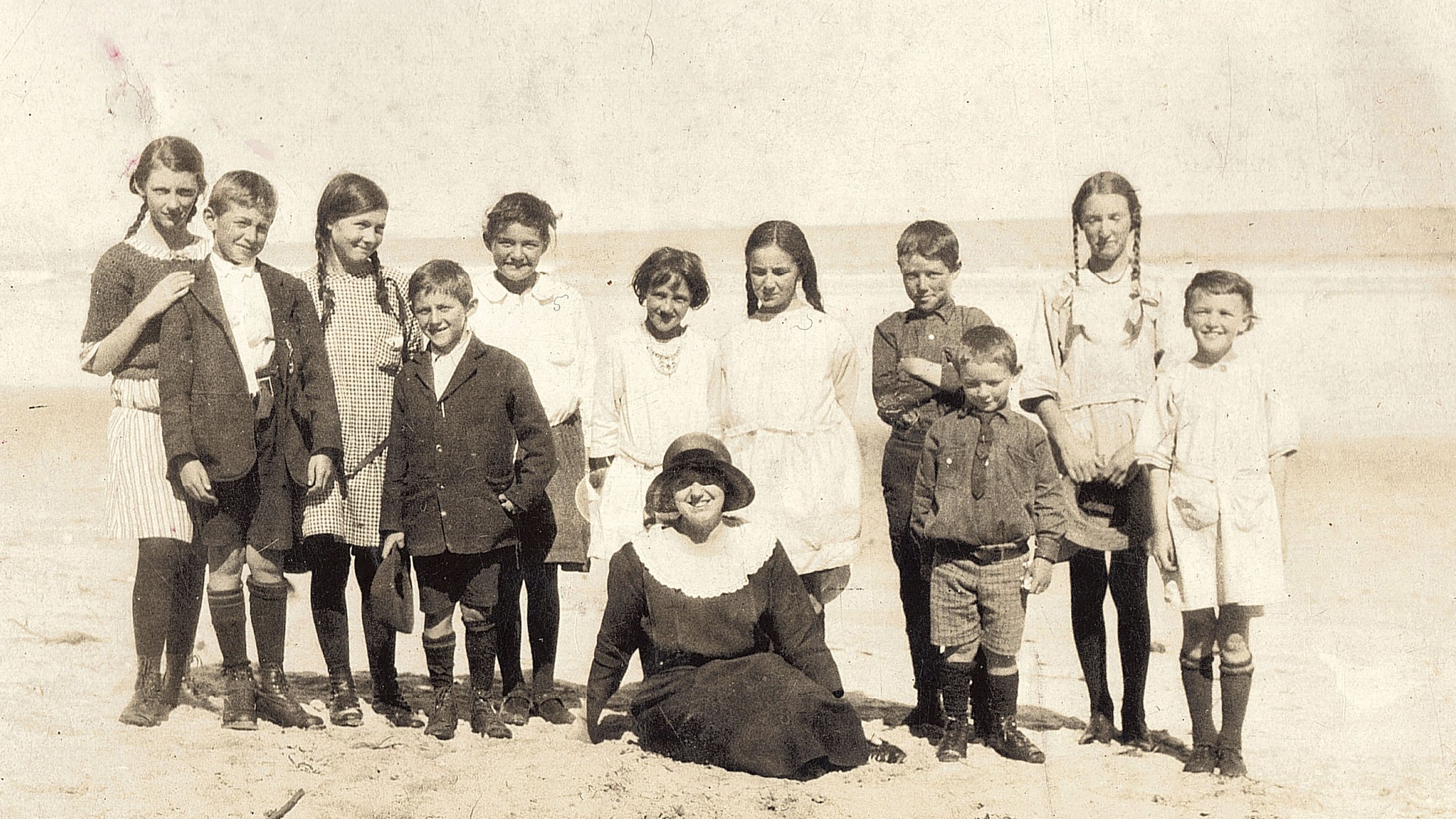
Early Settler Life
The Sandy Point State School
The children of the early selectors in Sandy Point were educated initially by a parent and ‘school’ was conducted in their homes. However, by 1919 there were ten children between the ages of 4 and 14 and the community was able to successfully petition the Education Department for a school and teacher.
The Sandy Point State School No. 3986, located on a large block near what is now 31 Ash Avenue, was first registered on 11 February 1919 and a head teacher (Mr Alexander King) temporarily appointed. The building itself was commenced in 1920 with the Department contributing £30 in lieu of rent towards the cost of materials. The parents contributed £70 and constructed the building. Despite delays with the delivery of furniture, the school was opened in 1921.
The site of the Sandy Point State School at 31 Ash Avenue
Sandy Point State School. Children on the beach with their teacher c.1923
The Education Department did not consider that the number of enrollments at the school warranted a full-time teacher. Much to the dissatisfaction of the parents, it was therefore decided teacher would work across two locations, teaching at both the Sandy Point and Waratah North schools. The Waratah North school was located at 675 Waratah Road approximately 11 km from the site of the Sandy Point School. At times, the students attended the Sandy Point school on three days of the week and the Waratah North on the other 2. This was reversed when the enrollment numbers change. However, the parents managed to persuade the Department that although the numbers of students from Sandy Point was lower, their attendance rates at school were far higher and therefore teaching should be conducted on three days a week at Sandy Point.
The school building itself was opened in 1920 and the first permanent teacher was Louisa O’Kelly. Louisa unfortunately resigned due to ill health and the many of the teachers that followed also found the conditions at Sandy Point challenging. A series of teachers were appointed over the years the school remained open, the last being Margaret Ebert who finished when the school closed in 1928.
Notice of termination of the lease of the school building was sent to the school on 25th May 1927. The decision had been made to close the school and the remaining students were to be educated by correspondence. The parents expressed their dissatisfaction with this arrangement, pointing in a letter that the nearest other schools that children could attend were Waratah Bay which was nine miles away Fish Creek which was 13 miles away. They also argued in the letter to the Department (PROV, VPRS 795/P0000, 3986) that:
“… education by correspondence requires supervision by parents and the vast amount of work and the multifarious duties imposed upon the parents at Sandy Point owing to their financial position render it impossible for them to give any reasonable supervision to the method of education suggested. The fathers are out working from daylight till dark and the mothers have got to attend to all the various matters appertaining to the households and owing to the distance from the nearest centre, bread and other food is not obtainable in the ordinary way and has to be made by the mothers.”
The parents managed to gain the support of the local member of parliament, Mr G.L. Davis MLA and were able to convince the Department to keep the school open until the end of the year. After the closure of the Sandy Point school, the building was taken down and materials sold off for re-use.
Communications
In the early days of settlement, the only form of communication was by mail which was collected and sent via sea from the settlement at Waratah (now Walkerville South). Once the railway line was completed between Melbourne and Fish Creek, mail was delivered to Fish Creek and transferred to Sandy Point by contractors. In 1892 Samuel Lowry was awarded a contract for the conveyance of mails to and from Fish Creek and Waratah Bay once per week. The service later increased to twice a week, and then three times a week.
Communication by telegraph became possible in the 1880s but availability was limited to larger towns. A telephone line network to Sandy Point was established in 1926. The initial telephone exchange and was operated out of the kitchen at ‘Doonagatha’.
The first postal agency was operated by Vi Pilkington in her home. It was moved to the Sandy Point general store in the 1960s, where it remains to this day.
Vi Pilkington taking a call on the telephone exchange in her kitchen in Gyndahnook in 1964.
Home | History of Sandy Point | Traditional Owners | European Settlers | Settlement at Shallow Inlet | Early Settler Life | Township of Sandy Point


